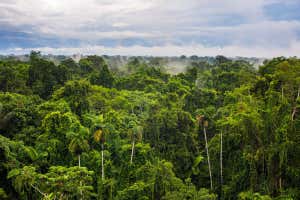
Earth is home to many more types of tree than previously thought, according to researchers who say thousands of species are still to be discovered in South America alone.
Peter Reich at the University of Minnesota and his colleagues found that the planet’s 3 trillion trees belong to an estimated 73,300 species, up more than 14 per cent on the number identified by scientists to date. The increase comes from an estimated 9200 extra undiscovered species, many of which are rare.
“It’s a celebration of life: everyone loves trees,” says Reich. “At the same time, it’s raising this emergency warning, that there’s a lot we don’t already know and a lot of [undiscovered species] are threatened and vulnerable because they’re rare.”
The figure also provides a yardstick to know if species are lost in the future, says co-author Jingjing Liang at Purdue University in Indiana.
The finding that South America is host to many of the undiscovered species isn’t a surprise, given that Amazonia in Brazil is vast and extremely biodiverse and there have been few field surveys of the area, says Reich. But ongoing deforestation – rates of which in Brazil rose last year to the highest level in a decade – could threaten many species before they are even formally described by researchers.
South America is also the continent with the highest number of rare species. Less common trees are at greater risk of being wiped out by a natural disaster or land use change by humans, and are less likely to be able to adapt to climate change. “Rare species are especially vulnerable, and losing these species will have ripple effects that impact entire ecosystems,” says co-author Thomas Crowther at ETH Zurich in Switzerland.
The researchers arrived at their findings by building on an existing global database of tree species, combining it with another data set of where trees occur and dividing the world into 100-kilometre-wide squares. They estimated the number of undiscovered species based on an approach that inferred more new species in areas known to have a high variety of species but low numbers of them, indicating that others were probably missed by surveys.
Reich thinks the estimate of 73,300 tree species globally may be a few thousand too low, because there are many parts of the world where there is almost no reliable tree data even at the scale of 100-kilometre squares. The main uncertainty in the global tally stems from a lack of field surveys in the tropics, says Liang.
Why does it matter that we know how many species there are? Diversity is critical to forests’ ability to continue to provide resources and other services, from slowing climate change and mitigating flooding to being a source of timber and home to other flora and fauna, says Reich, so conserving them will be vital.
“I am not surprised the number of undescribed is estimated at 9200: 2000 new plant species are described every year, including many tree species,” says Emily Beech at Botanic Gardens Conservation International, a plant conservation charity based in London. “There are many areas that are poorly known so could well hold that many species. It matters because unless things are named, it makes it difficult to conserve the species.”
“That number [9200 new tree species] is a humbling reminder that there’s so much we still have to learn, and so much wonder left to discover,” says Crowther.
[“source=newscientist”]




